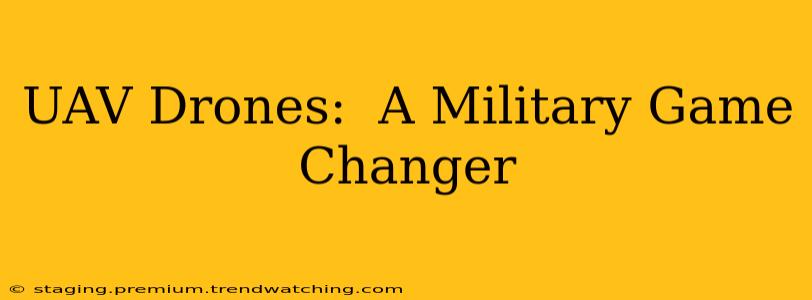Unmanned Aerial Vehicles (UAVs), commonly known as drones, have revolutionized modern warfare. Their impact extends far beyond simple reconnaissance, transforming battlefield tactics, intelligence gathering, and even combat operations. This comprehensive overview delves into the multifaceted influence of UAV drones in the military landscape, exploring their capabilities and implications.
What are the Different Types of Military Drones?
Military drones come in a wide array of shapes and sizes, each designed for specific tasks. Broadly, they can be categorized based on their size, altitude, and operational range. Smaller drones, often referred to as micro or mini UAVs, are excellent for close-range reconnaissance and surveillance. Larger drones, including medium-altitude, long-endurance (MALE) UAVs like the MQ-9 Reaper, can remain airborne for extended periods, conducting persistent surveillance and carrying out precision strikes. High-altitude, long-endurance (HALE) UAVs operate at significantly higher altitudes, providing broader surveillance coverage. The capabilities vary significantly depending on the specific model and its intended use.
How are Military Drones Used in Modern Warfare?
The applications of military drones are incredibly diverse and constantly evolving.
Intelligence, Surveillance, and Reconnaissance (ISR): This remains the most common use. Drones equipped with high-resolution cameras, thermal imaging, and other sensors provide real-time intelligence, allowing commanders to make informed decisions on the battlefield. Their ability to operate in hazardous environments, inaccessible to manned aircraft, significantly enhances situational awareness.
Precision Strikes: Many modern drones are armed with missiles and other munitions, capable of carrying out precision strikes against designated targets. This minimizes civilian casualties compared to traditional air strikes and allows for targeted engagement of high-value assets.
Electronic Warfare: Drones can be equipped with electronic warfare systems to jam enemy communications, disrupt radar, and even disable enemy drones. This capability provides a significant advantage in modern conflict.
Search and Rescue: Beyond combat roles, drones play a crucial part in search and rescue operations. Their ability to cover vast areas quickly makes them invaluable in locating survivors and assessing damage in disaster zones.
Border Patrol and Surveillance: Drones are increasingly used for border security, providing persistent surveillance of vast stretches of land and sea, helping to detect and deter illegal activity.
What are the Ethical and Legal Concerns Surrounding Military Drones?
The use of military drones raises significant ethical and legal questions.
Accountability and Transparency: The lack of a human pilot directly involved in the targeting process raises concerns about accountability for civilian casualties and potential violations of international law. Determining responsibility and ensuring transparency in drone operations remains a critical challenge.
Civilian Casualties: While precision strikes aim to minimize civilian casualties, the reality is that mistakes happen. The potential for unintended harm and the difficulty in verifying the accuracy of drone strikes are major ethical concerns.
International Law and Regulations: The legal framework governing the use of armed drones is still developing. Questions about the legality of drone strikes in different contexts, the right of self-defense, and the protection of civilians require further international consensus.
What is the Future of Military Drones?
The future of military drones is promising, with ongoing advancements in technology promising even greater capabilities. We can anticipate:
- Increased Autonomy: Greater reliance on artificial intelligence (AI) will lead to more autonomous drones capable of carrying out complex missions with minimal human intervention.
- Swarming Technology: The use of swarms of smaller drones working collaboratively will increase operational flexibility and resilience.
- Advanced Sensor Technologies: Improvements in sensor technology will further enhance intelligence gathering capabilities.
- Integration with other Systems: Greater integration of drones with other military systems will enhance situational awareness and coordination.
How Effective are Drones in Modern Warfare?
The effectiveness of drones in modern warfare is demonstrably high. Their ability to provide persistent surveillance, conduct precision strikes, and operate in hazardous environments gives them a significant advantage over traditional platforms. However, their effectiveness is also influenced by factors such as enemy countermeasures, environmental conditions, and the overall strategic context. Their impact is continually evolving with technological advancements and changes in military doctrine.
Are Drones Replacing Manned Aircraft?
While drones offer many advantages, they are not entirely replacing manned aircraft. Manned aircraft still provide capabilities that drones currently lack, such as superior maneuverability in certain situations, faster response times in urgent scenarios, and the ability to handle more complex tasks that require human judgment and adaptability. The future likely involves a synergistic approach, with manned and unmanned aircraft operating together to maximize their respective capabilities.
The use of UAV drones in the military signifies a significant shift in the landscape of modern warfare. While their capabilities offer immense potential benefits, careful consideration must be given to the associated ethical and legal implications to ensure responsible and effective deployment. The ongoing technological advancements in this rapidly evolving field will undoubtedly continue shaping future military strategies and operations.

